

OM4 Fiber Standard Approved TIA To Reconsider High Connector Loss in TIA-568 Standard Where Will Broadband Stimulus $$ Be Spent? RFOG: CATV's FTTH FOA Updates Certifications, Creates Book From Reference Website FOA Online Fiber Optic Reference Guide It keeps expanding- soon to be available in book form - and "Google Custom Search" Tech Topics: New Listings of International Standards. See Tech Topics Below. Q&A: Some very good questions this month on loss budgets and OTDRs! Product News: Know what a "chute" is? It's something you need with conduit. See "Product News" Below Worth Reading: Economic crisis fueling open network interest (8/09), Plenty of IT Jobs Even In A Recession? Cellular Wireless Needs More Backbone Capacity, iPTV Growing Fast. Cincinnati Bell Competes With Cable. See "Worth Reading" below
|
It's now CFOT® The FOA CFOT® (Certified Fiber Optic Technician) is now a registered trademark. With over 25,000 fiber optic techs holding CFOTs and the CFOT being recognized worldwide as the foremost certification in fiber optics, the FOA realized the value of the CFOT required trademark protection. Now it's official! Want to know more about fiber optics? Looking for specific information? Study for FOA certifications? Here's the largest technical reference on the web: The FOA Online Fiber Optic Reference Guide. Contact the FOA |
| You can now renew your FOA certification online - and get an extra month free. Details here. |
New FOA Book Finished, At The Publisher 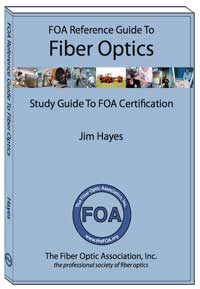 The new FOA book, the FOA Reference Guide To Fiber Optics, is finished and at the publisher, so it will be available on schedule this fall. The updated book is intended to be used in training for FOA certification and as a reference book for contractors, installers and end users of fiber optics. The FOA Reference Guide To Fiber Optics and The FOA Online Fiber Optic Reference Guide will be the official reference for the 2010 CFOT exams. This book, which benefits from 12 years of experience with our previous book, The Fiber Optic Technicians Manual, is better organized for use both as a reference and as a textbook. And since we are self-publishing the book using more modern "publish on demand" technology, it will be easier to keep up to date and much cheaper! Here is more information on the FOA Reference Guide To Fiber Optics. OM4 Fiber Standard Approved The TIA Standards Committee hs approved a new grade of multimode fiber, OM4, under TIA 492AAAD. This new grade of 50/125 laser-optimized fiber has been debated within the multimode fiber industry for nearly 3 years as networking moves to 40 and 100 GB/s over short distances on multimode fiber and needs higher bandwidth. EIA/TIA 492AAAD standardizes the specification and measurement methods of the new higher bandwidth fiber which similar to those already commercialized by Corning, OFS and other fiber manufacturers. The requirements of the OM4 standard are identical to OM3 with the sole exception of the bandwidth values. Both the 850 nm EMB and the 850 nm over-filled launch (OFL) bandwidth have been increased from the OM3 requirements.
The difference between "High Performance EMB" and "Legacy Performance EMB" is the test method. A new test method simulating a VCSEL laser launch (TIA-455-220A and IEC 60793-1-49) was deemed appropriate for these fibers which are intended for use with VCSELs at higher speeds. OM4 will undoubtedly become the new standard for high bandwidth multimode applications, particularly data centers. Whether it replaces OM3 in more networks will depend on pricing. Here are links to Corning and OFS OM4 fiber information. TIA To Reconsider High Connector Loss in TIA-568 Standard One of the problems with standards is they are written as "minimum" specifications, specs any manufacturer can meet but can still brag that their product not only meets the standard but is better than the standard. This creates some awkward situations, for example in fiber optic connectors. Since it was written in 1991, the TIA spec for premises cabling, TIA-568, has specified connector loss as 0.75 dB maximum. Other than prepolished/splice connectors with the cheap "stapler" cleaver in the toolkit, no fiber optic connector has been this bad since long before TIA-568 was written. At a June, 2004 meeting, FOA presented recommendations for the update of TIA-568-B, which was just starting. Among our comments: "A.3.2 Attenuation The limit of 0.75 dB for all connectors is inappropriate and can cause field problems. While we understand the need for setting GO/NO GO performance levels at such high levels if it covers all termination types and processes, it creates a serious problem in many applications." (You can read the whole recommendation which has been on the FOA website since June, 2004: http://www.thefoa.org/568Crev.pdf) TIA-568-C, however, continued with the 0.75 dB connector loss and was recently ratified. Now, one member of the fiber committee has brought to the attention of the TR 42.8 fiber committee that using the TIA-568-C standard, a simple cable plant with connections on each end and two intermediate connections (either from intermediate patchpanels or the array connectors on prefabricated cabling systems) will not meet the loss budget of the 100G Ethernet proposals and even some current 1 and 10G Ethernet standards. Obviously someone has begun reading what they write, since Annex E of TIA-568-C.0 shows loss budgets for many networks that will not work over anything but a straight cable with connectors on each end according to TIA-568 standards! ISO/IEC has already changed to a spec that 95% of the connectors must meet a 0.5 dB loss standard for multimode, 0.4 for SM. TIA will be considering this issue at the next meeting in November. Where Will Broadband Stimulus $$ Be Spent? Lots will go to fiber optics. We attended one of the FCC/NTIA/RUS regional meetings recently to see what they are looking for and to talk to some of the participants. The speakers were careful to not promote any technology, but say that fiber has a big role in providing a broadband backbone. A big issue in rural areas is how to distribute broadband. We talked to two rural groups who are using point-to-point wireless in mountainous areas successfully. In order to expand, they need to add links to every house, of course, but they also have problems with getting high speed Internet access to connect their organization to. For their connection, they depend on fiber optics and larger companies or government agencies to bring fiber to their small town headquarters. FTTH systems are of course part of the plans of many applicants. With the deadline for the first wave of applications passed, we may hear soon what projects will be funded. RFOG: CATV's FTTH CATV operators need something to combat their subscriber’s clamoring for fiber to the home, which has lead to the development of RFOG, "RF over Glass." RFOG is basically nothing more than an all-fiber HFC/cable modem system built with less expensive components now available thanks to the volume pricing of components used in FTTH. It’s designed to operate over a standard telco PON (passive optical network) fiber architecture with short fiber lengths and including the losses of a FTTH PON splitter. 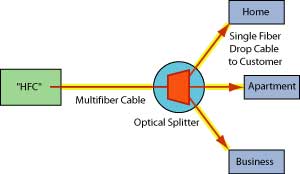 There is one interesting side effect of this approach. Now telcos and CATV companies can deliver the same services over the same cable plant using totally different technologies. But that means that office or apartment building owners, developers or even whole towns that might be considering installing FTTH infrastructure themselves and leasing the fiber to a service provider can have a choice of service providers. One cable network can support either CATV or telco systems – or even someone else for that matter. That opens up a big market for private fiber optic systems. Using Unused TV Channels For WiFi TV offers another option for broadband distribution, wireless over unused TV channels. Developers are working on wireless hardware to broadcast WiFi over "white spaces" - unused TV spectrum. Such a system could be a boom to rural areas, as distances of a mile are easily handled. And of course, the Internet backbone would be fiber. Read more in MIT Technology Review. This option may compete with WiMAX which is having problems. More. Updated FOA Certifications As part of the annual review process, the FOA enlists the assistance of dozens of experts to review our certifications and exams. That allows us to keep them up to date and even flag changes in our reference materials and Online Reference Guide. We have made some changes that should interest our FOA members and schools. FOA CFOTs with the proper experience can now more easily apply directly to the FOA and, if qualified, take the certification exam online locally with a designated proctor. Manufacturers' training, e.g. testing, connector or splicing training, will qualify as experience. Shortly, you will be able to study using an online study guide. If interested, download a FOA Logbook and document your experience. FOA schools should look at the CFOS certifications as the requirements for teaching classes has been clarified to include classroom and lab requirements. Now more courses will qualify for CFOS training, including, for example, OTDR training for CFOS/T or prepolished/splice connectors for CFOS/C. Check out the new CFOS page or contact the FOA for details. What are people saying about the new FOA CPCT Premises Cabling Certification covering fiber/copper/wireless? You have done a fine job, I found the test to be right on the money with today's need's. Questions were geared to real world applications. We needed this in the industry. This is only one of the reasons FOA certification shines. This is practical instruction for our industry. While most premises cabling certifications only cover "Cat 5" unshielded twisted pair (UTP) cabling, the FOA CPCT covers premises cabling the way it is being used today - not ten years ago! Now most premises networks use fiber backbones, UTP cables to the few desktops now being used and cabling to wireless access points for laptops and other WiFi- connected devices. Those who have experience in the field of premises cabling, even if they do not have a CFOT, can apply for the CPCT certification directly to the FOA. To facilitate preparing for the CPCT exam, the FOA has created the Premises Cabling section on the Online Reference Guide and created a CPCT Study Guide for the exam. FOA Online Fiber Optic Reference Guide New Book Based on the FOA Online Fiber Optic Reference Guide  The FOA Online Fiber Optic Reference Guide has become very popular - perhaps the most popular technical website ever, typically with over 30,000 users monthly! Websites are great because they are available free to everybody and easily updated, but since many teachers need a printed textbook and others want a book to have for reference, we've created the FOA Reference Guide To Fiber Optics, a printed version of the technical materials on the website, organized for training and keyed to FOA curriculum materials. Based on lots of feedback from trainers at FOA-Approved schools and FOA members, we think you will agree this is the best FO reference for trainers, students, installers, contractors, and users ever. Wanted: Links To Technical Materials Next, we're soliciting links from fiber optic manufacturers and other organizations that have created technical materials that would be of interest to our readers. If you have technical websites you want to share, go here for our guidelines for submission. FOA Offers "Google Custom Search to Tech Topics and Online Fiber Optic Reference Guide  There's so much information on the FOA Tech Topics and Online Fiber Optic Reference Guide
that even a well-organized Table of Contents isn't enough and when the
material is always changing, an index is impossible to maintain. So the
FOA is using the latest technology in search, Google Custom Search,
which will allow you to search just the FOA Tech Topics and Online Fiber Optic Reference Guide for any topic you want to find more about. Try it! There's so much information on the FOA Tech Topics and Online Fiber Optic Reference Guide
that even a well-organized Table of Contents isn't enough and when the
material is always changing, an index is impossible to maintain. So the
FOA is using the latest technology in search, Google Custom Search,
which will allow you to search just the FOA Tech Topics and Online Fiber Optic Reference Guide for any topic you want to find more about. Try it! Go to The FOA Online Fiber Optic Reference Guide. Featured School: Good Question! Tech Questions Worth Repeating Loss Budgets (A question we get all the time!) Q: Why do we count the connectors on each end of the link that will plug into our equipment as one connector alone has "no loss"? If you could shed some light on this subject it would be greatly appreciated. A: We count the connections on each end for several reasons. 1) When we test the cable plant per OFSTP-14, we use launch and receive reference cables which will include the end connections in the tests. Without including them in the loss budget, we would reject many cable plants because the tested value will be higher by two connections. 2) Network standards include the connectors on the ends since most installed cable plants are from wall or rack connection outlets to another wall or rack connection. When equipment is attached, it will be done by patchcords which will have a loss when connected to the outlet. Adding them into the loss budget therefore matches the usage. OTDR Calibration: Matter of Semantics Q: Where do you source the "gold plated" fibre used to calibrate OTDRS? I have a customer who is setting up a laboratory for calibrating optical fiber test instruments. They are under the impression that the calibration of OTDRs is undertaken when carrying tests on gold coated optical fiber. A: I think what we have here is a semantic misunderstanding! But first some background. There are two ways to calibrate OTDRs. One uses electronic means to calibrate the timebase (distance scale) and power (dB) by using the OTDR pulse as a trigger to send a calibrated ramp of optical power decreasing over time to use for calibration. It's uncertainty is determined by the precision of the calibrators ramp signal. The second method is to use a fiber of known characteristics: length and attenuation coefficient. The fiber is calibrated by a "transfer standard" OTDR and sold for use by anyone wanting to calibrate their instrument. Traditionally, calibration standards like this have been referred to colloquially as a "gold standard" or in this case as a "gold fiber." I believe what we have here is a misinterpretation of what a "gold fiber" is, construed as a "gold-plated fiber. Gold plating a fiber would not, of course, make any difference in its performance, other than make it conductive! OTDR Field Use - Creating a "Launch Cable" Q: I'm in the field and need to test a cable with an OTDR but have no launch cable. What can I do? A: If you are testing a multifiber cable that's long enough to test with an OTDR and you have already tested it with an OLTS (like standards require) so you know the fiber is good, you can use one of the fibers in the cable as a launch cable. Set up as below and simply have another tech connect up the fiber being used as the launch cable to the other fibers to test each of them. If you want to test from one end by yourself, loopback from the far end and then use the two fibers as the launch cable to connect up to other fibers from the same end as the OTDR (second drawing.) If you have access to both ends, you can continue looping back and get many fibers on one trace, to the length capability of the OTDR.   Followup: Q: We've got a hybrid military cable assembly with a multipin 38999 connector on one end and SCs on the other. How do we test it? The manufacturer gave us a SC to "pin probe" with a mating pin as a reference cable. A: Here a picture is worth at least a thousand words. The trick involved is to use two tests, one for each end of the cable, resetting the "0 dB reference" for each test. You need a meter or OLTS with adapters on the detector unless, as in this case, the pin is a 2.5 mm ferrule just like the SC, so a universal adapter will work. 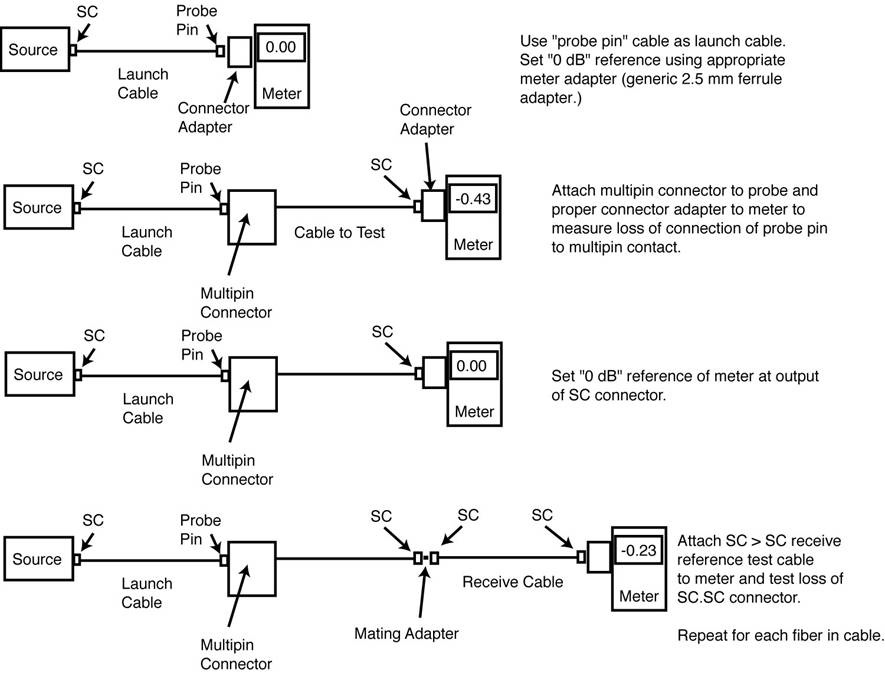 OTDRs vs Fusion Splicing Machine Readings Q: When we fusion splice, the fiber machine shows splice losses of 0.00 to 0.04 dB, but tests with an otdr shows splice losses of 0.2 to 0.3 dB. Why? A: There are several issues involved. The splicer uses a profile alignment system (http://www.thefoa.org/tech/ref/termination/fusion.html ) that estimates the losses based on software estimates of how well the fibers are aligned. It's just an estimate, as it cannot actually measure the loss, and issues like differences in the mode field diameters or backscatter coefficients of the two fibers can make a big - and directional - difference in the losses measured by an OTDR (http://www.thefoa.org/tech/ref/testing/OTDR/OTDR.html). With the OTDR you should measure both ways with the OTDR and average. I suspect the larger losses could be directional issues with the OTDR and if you measure the other direction you will get lower losses. Measurement Uncertainty: Everyone testing fiber optics should understand that every measurement has some uncertainty - whether you are measuring loss, length, wavelength, power, etc. Knowing that uncertainty is very important to interpreting the measurement. It's worthwhile to read and understand the issue of measurement accuracy covered in this page of the FOA Online Fiber Optic Reference Guide. Worth Reading: Economic crisis fueling open network interest (8/09) The economic crisis is prompting countries such as Australia and the US to rethink their broadband strategies and to consider open network infrastructures that will support applications from multiple sectors such as health care, education and energy, according to a new report by Australian consultant Paul Budde Communication. From Telephony Online: More. Plenty of IT Jobs Even In A Recession? (7/09) It seems that way. An article in the Washington Post points out the needs for skilled IT workers as spending especially in energy and healthcare are strong. The bad news is salaries are down. More. Cellular Wireless Needs More Backbone Capacity, iPTV Growing Fast (7/09) Backbone build-out is urgently needed to keep pace with demand for video and other bandwidth hungry services. Growth of 15.2 percent is expected in 2009 alone. IPTV revenue will nearly quadruple from $5.3 billion in 2008 to $20.8 billion in 2012, a 40.8 percent compound annual increase. Overall voice, data and video revenue will reach $1.7 trillion in 2012, growing at a 5.9 percent compound annual rate.. TIA. TIA ICT Market Report. Cincinnati Bell Competes With Cable (7/09) Cincinnati Bell Inc. is extending its ability to bring more than 250 TV entertainment channels and faster Internet service into apartment and condominium complexes across Southwest Ohio and Northern Kentucky at light speed. More. Good Technical Websites American Polywater (http://www.polywater.com/) has one of the best technical website for cable installers. Here is a rundown on some new material on their site. Cable Installation using "Push" or "Push/Pull" Polywater's new Pull-Planner™ 3000 Software allows a "pushing force" variable in pulling tension calculations. Read a White Paper that quantifies the push contribution and compares calculation results to field experience. -- http://www.polywater.com/pushing.pdf Pulling Cable Through Water? Read a Product Spotlight on Polywater® + Silicone™, Polywater's new generation underground lubricant. Continued reduction of friction when pulling through water is only one of the unique features of this lubricant. -- http://www.polywater.com/NNNBSL.pdf Check out their website, especially “Videos,” “Engineer’s Corner” and “Calculators.” http://www.polywater.com/NNNBSL.pdf  " Heard on the Street" is a monthly online newsletter from Frank Bisbee of Communications Planning Corporation that covers the telecommunications and cabling businesses. Each month includes news from manufacturers, trade associations and professional societies like the FOA. You can read the current issue and back issues online.  JDSU has announced the See the Light webinar series, a four-part program designed for anyone involved in the installation, maintenance, and repair of fiber optic systems. It begins with fiber inspection and cleaning and then covers the basics of fiber testing. The webinar series then continues with the more advanced optical time-domain reflectometer (OTDR) and fiber local area network (LAN) testing challenges. More information on the series. IGI, a major market research and technology reporting company (the "Active Optical Cables" below) is offering a a free one year subscription to one of our fiber optics newsletters to FOA members. All they have to do is to send IGI an e-mail stating which newsletter they would like to get. See http://www.igigroup.com/nl.html for a listing of IGI Newsletters. The new FOA reference website is now online. New sections have been added on fusion splicing and mechanical splicing. Check out the current Table of Contents. Coming soon to a network near you - 40 and 100 gigabit/sec Ethernet! The IEEE is already working on specs for 40 and 100 gigabit/sec Ethernet and have approved a number of new PMDs (that's standards-speak for Physical Medium Dependent - i.e. cabling). A summary of the proposals is on the updated list of network specs at http://www.thefoa.org/tech/Linkspec.htm.
"Chutes" For Blowing Lines Through Conduit 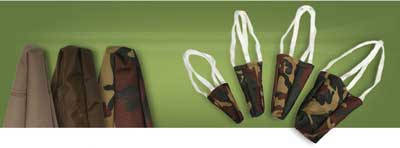
Motorola Introduces LAN Based on FPON FTTH Network Motorola’s Passive Optical LAN (POL) system derives from the vendor’s experience supplying gigabit passive optical network (GPON) equipment for Verizon’s fiber-to-the-premises network. Motorola’s POL is an all-fiber enterprise LAN connecting any stationary Ethernet-based device or system across the enterprise into the wide area network. It supports cabled and wireless connections and is certainly something anyone looking to upgrade a LAN should consider. (One would assume that supplying millions of pieces of hardware to Verizon means they have gotten the price low!) 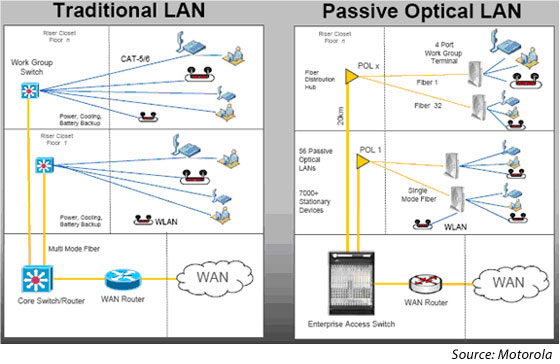 Read more from CED. Used Test Equipment – Buy or Sell http://www.testequipmentconnection.com/ Have you read the FOA Tech Topics on Cleaning? More links on cleaning: Cleantex Alco Pads David Chaffee's FTTH Prism Newsletter is Online (archives are at bottom of page) Verizon Ups FiOS Speeds in NY Verizon is offering faster FiOS speeds in NY and even getting into the TV biz with a local channel. Telephony. In Norway, You Might Have To Bury Your Own Cable To Get FTTH! A Norwegian triple-play provider has a unique solution to the pesky problem of digging up consumers' yards to bury fiber-to-the-home. Lyse Tele, an overbuilder that launched its fiber-based all-IP solution in 2002, installs the fiber right to the edge of a customer's lawn, then gives the customer instructions on how to bury their own fiber cable to the house. Read More From Telephony.
|
||||||||||||
What Is The FOA? Hear FOA President Jim Hayes tell the FOA Story in a 2-part interview by Sound & Video Contractor Contributing Editor Bennett Liles. It tells about the FOA history, goals and achievements. Part 1: http://svconline.com/podcasts/audio/fiber_optic_association_part1/index.html. Part 2 http://svconline.com/podcasts/audio/inside-fiber-optic-association2-0924/index.html. |
||||||||||||
|
Digging Safely (Read the FOA Tech Topic) There is a new toll-free "call before you dig" number: 811 See www.call811.com for more information National Fiber Optic Protection Summit: By the "811" group. March, 2008 in Vegas.
|
||||||||||||
|
||||||||||||
|
Splicers - Canada (7/09) My company - Telco Direct Services Inc. Is currently under contract in Vancouver and the lower mainland and I require fiber splicers for approx 3 months possibly longer term. Rate of pay will be $40-50 depending on experience. Contact: telcodirect@shaw.ca Jeff Bondon - 647-892-6901 CEO Telco Direct Services Inc. Instructor/San Diego (6/09) "Private College looking for an Instructor to teach Cabling and Fiber Optic Classes". Part and Full time positions available. Campus located in San Diego, Contact Gary at 619.234.2181, Ext. 312 Do listings in the FOA Newsletter Work? Here's feedback: "We did great! We have over 15 interviews next week." Thanks, David Swales, Jr.
|
||||||||||||
|
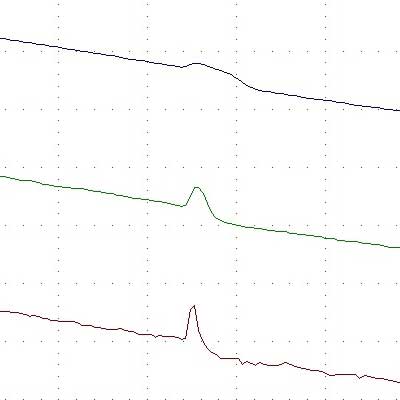
Your Name, CFOT - It pays to advertise! The FOA encourages CFOTs to use the logo on their business cards, letterhead, truck or van, etc. and provides logo files on this site for that purpose. But we are also asked about how to use the CFOT or CFOS certifications. Easy, you can refer to yourself as "Your Name, CFOT" or "Your Name, CFOS/T" for example. Feel free to use the logo and designations to promote your achievements and professionalism! |
||||||||||||
|
Remember To Renew Your Certification ! Remember
to renew your FOA certification. All current CFOTs have a ID Card with
their certification data and we keep a database of current CFOTs to
answer inquiries regarding your qualifications if needed. You must be a
current FOA member and CFOT to participate in our online
database of installers, contractors, technicians and consultants.
If you forgot to renew, use the online application
form to renew NOW! You can now renew your FOA certification online - and get an extra month free. Details here. |
||||||||||||
|
|
||||||||||||
|
||||||||||||